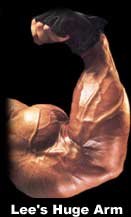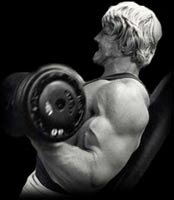Be that as it may, for better or worse, our own industry benchmark for perceived power, male virility and strength is big and vascular biceps! Yes our mantra has been to screw both the washboards (which really, any lamebrain can get) and screw the coronary wall perfusion. Give us the 19" and 20" big guns instead baby!
If you want big, vascular and complete biceps, within your genetic structural framework, then face it, you have to be willing to put in years of pain and punishment training.
And you know, the genesis for great biceps can really be broken down into one word - CURLS. CURLS NOT JUST FOR GIRLS!
You say you want some curl variations? Here's a short big guns list:
- Standing barbell curls - View Exercise
- Close-grip standing barbell curls - View Exercise
- Seated barbell curls - View Exercise (DB shown)
- Cheating barbell curls
- Alternate dumbbell curls - View Exercise
- Scott or preacher curls - View Exercise
- Cable curls - View Exercise
- Concentration curls - View Exercise
- EZ-bar curls
- Overhead cable or Nautilus Machine overhead curls
 The exercise key to great arms? Well first, it's not that difficult really. Provided you get good sleep and lots of protein and calories, then by doing an adequate number of sets (training volume) often enough, with good form and high intensity (relative percentage of your maximum weight), you can develop some very impressive arms. Over time, you should be able to obtain a pair of great Priest-like arms (well, almost anyway).
The exercise key to great arms? Well first, it's not that difficult really. Provided you get good sleep and lots of protein and calories, then by doing an adequate number of sets (training volume) often enough, with good form and high intensity (relative percentage of your maximum weight), you can develop some very impressive arms. Over time, you should be able to obtain a pair of great Priest-like arms (well, almost anyway).
No doubt there is sometimes a fine line between training heavy and too heavy. We feel that you should use weights that you can control with sensory feel, but heavy enough that you fail at the end of your prescribed rep range, and you must get adequate recovery.
Remember, the biceps area and associated tie-ins are fragile to chronic strain. In fact, no one we know ever developed huge, complete arms by training them heavy more than twice a week - especially non-steroid users.
Recommended Reps For Bicep Development
We suggest strongly that for biceps work you keep your reps in the 8 to 15 range as the best modicum for size, shape and strength. Of course, you must train progressively and try to add weights regularly or get an extra rep with the same weight.
We also advocate that you do some medium-rep sets with heavy weights and some sets of higher reps with (relatively) lighter weights. You can also warm-up very well and then start with your heaviest weight and work down to a light weight (which isn't going to seem very light by then). You can also do several partial reps (burns) following your full reps to failure.
Like everything, from sex to making apple pie, form is important. To become a good curler, you must pay attention to the position of your wrists, elbows and shoulders/traps as you do your various biceps exercises.
 You may wonder what the shoulders and traps have to do with proper curling. Too many bodybuilders actually shrug the barbell or dumbbells halfway up with their delts and traps and then finish the curl at the top with their biceps. They do not curl the weight all the way up with just their biceps. You see this practice especially on alternate dumbbell curls which become more like mini dumbbell power cleans. As to that style, as Nancy Reagan argued, "just say no." Just don't do it.
You may wonder what the shoulders and traps have to do with proper curling. Too many bodybuilders actually shrug the barbell or dumbbells halfway up with their delts and traps and then finish the curl at the top with their biceps. They do not curl the weight all the way up with just their biceps. You see this practice especially on alternate dumbbell curls which become more like mini dumbbell power cleans. As to that style, as Nancy Reagan argued, "just say no." Just don't do it.
Shrugging might have made Ayn Rand famous, but doing it with your traps and deltoids is another subtle form of cheating. There is nothing wrong with cheating if you know how to put most of the overload on the target muscle group, but if you cheat because it's the only way you can move the weight then it is too heavy for proper form.
When you curl, lift your chest on full inspiration as you begin each repetition of curls. Don't use your traps to shrug the weight up. Lean back a little if you must to help lift the bar past the sticking point, but do not shrug or heave with your traps. Keep your chest arched high and your rear deltoids down. As much as you can, curl the weight up smoothly with biceps power only.
Another thing, if the barbell or the dumbbells can touch your shoulders at the top, you're curling incorrectly. If you keep the wrists locked and straight, the fully contracted position of the biceps becomes between 10 and 11 o'clock, not 12 o'clock. (For Greg Kovacs this may even be 8 o'clock.) So keep your biceps fully contracted.
The finish position of all curls at the top is actually never for resting. What about your elbow position? We like them fairly tight to your body, but maintain some natural body motion.
Working The Whole Arm
The coracobrachialis although the smallest muscle of the upper arm, helps full development. It adds fullness to the upper arm, especially since it is closely related to the short head. The brachialis lies beneath the long and short heads of the biceps, overlaps the elbow joint and is the elbow joint workhorse no matter if your wrists/hands are supinated (palms up) pronated (palms down) or in mid-position (think hammer curls). The good news is that curling works all these muscles, more or less.
We call the "belly" the real meat of the muscle so basic curls with heavy weights should target the belly of the biceps and should always be included in your routine. Fortunately the basic barbell curl and cheating barbell curl are great biceps-belly exercises and take care of its development quite nicely, thank you. Gee, even the neglected seated barbell curl also is a fantastic biceps-belly movement.
Influencing or modulating natural arm flexor or biceps peak is controversial. Most writers extol the long head of the biceps as it theoretically relates to peak, but if you asked 10 bodybuilders which exercise develops peak; you'd get 10 different answers. Rest your pondering mind since bodybuilding simply is always about where you put the stress on the muscle.
In theory, a fantastic peaking exercise is the bent-over-freestyle one-arm concentration curl or even the fixed concentration curl seated with the elbow of the working arm resting on their inner thigh.
In terms of theorizing peak, it's similar to doing a one-arm preacher curl using the 90-degree Scott bench. Why? Because in these positions, you anatomically pre-flex your shoulder joint so the long head of the biceps is shortened over the shoulder joints since it is a two-jointed muscle. Physiology, therefore, dictates that it is weaker at the elbow joint so this supposedly means it has to work harder to keep up with the short heads of the biceps.
It's the same scenario as the overhead Nautilus curl machine where your upper arms are up over your head. Here the long biceps heads are really shortened over the shouder joints and they really cramp and struggle to keep up with the better-leveraged short heads. Your choice of curling exercises is as important as how you do them. You must do exercises that train all aspects of the biceps and your brachialis. Herein is a routine we really recommend.
Do 4-5 sets of the straight-bar barbell curls, and 3-4 sets each of the other exercises, depending on your condition, age, recovery ability, stress levels, injuries and so on.
Planet Muscle Biceps Training
Standing Barbell Curls (Straight Bar) - View Exercise
This is THE biceps mass/size builder since it supremely adds mass and thickness to the belly of the biceps beast, especially as you curl relatively heavier weights.
We detest exercise robotics. Personal nuance suggests that a bit of body movement and rhythm may be warranted to get your biceps-building groove on. So, if you use some natural momentum to curl the bar past the 90 degree sticking point, don't sweat it, but use "pure biceps contraction" as much as possible. Always lower your weight slowly (more for safety as opposed to the negative-resistance-get-bigger nonsense). In short, never just drop the weight.
Try the up and down Pyramid Principle and do the following reps. Rest about 2-3 minutes between sets:
- 1 x 15 reps (warm-up)
- 1 x 15, 1 x 12, 1 x 10, 1 x 6-8 and
- 1 x 15-20 (pump down set)
Alternate Dumbbell Curls - View Exercise
This exercise is a great mass-builder. We like the first 6-8 reps alternately and the last 2-6 reps of a set done together! With alternates, lean from side to side as you curl the dumbbells to your shoulders. It's the groove-on thing. BUT - curl the dumbbells up, don't swing them up. Remember to inspire your way to a high chest as you curl. Try this:
- 1 x 15-18 to failure
- 1 x 10-12 to failure
- 1 x 6-10 to failure
The Hammer-Of-Thor Curls
This exercise is a variation exercise, curling dumbbell curls across your chest to the opposite shoulder. (Also called Zottman curls.) You should get an interesting contraction and a cramping sensation if you do these properly. Try just 2 sets of 10-12 reps with each arm.
Concentration Curls - View Exercise
To finish with a humongous pump and burn, do 1-2 sets of 15-20 reps as heavy as you can go. Try this routine twice every 10-12 days. Here it is summarized:
- Barbell curls - 1 x 15 (warm-up), 1 x 15, 12, 10, 6-8, and 15-20
- Alternate dumbbell curls - 1 x 15-18, 1 x 10-12, 1 x 6-10
- Hammer curls - 2 x 10-12
- Concentration curls - 1-2 x 25-20
 Click Here For A Printable Log Of This Workout!
Click Here For A Printable Log Of This Workout!
Thanks,
Jeff Everson & POWERTEC
